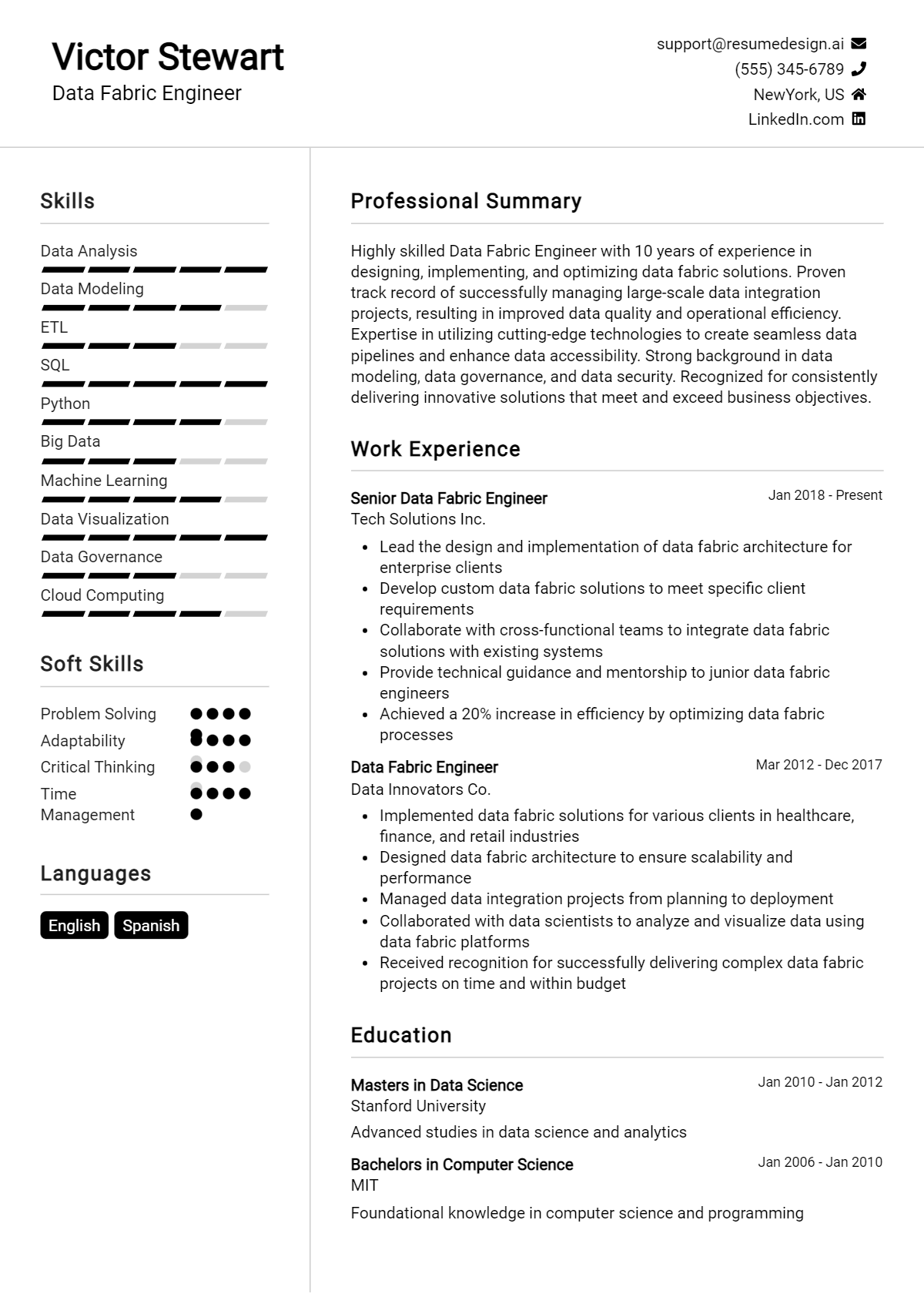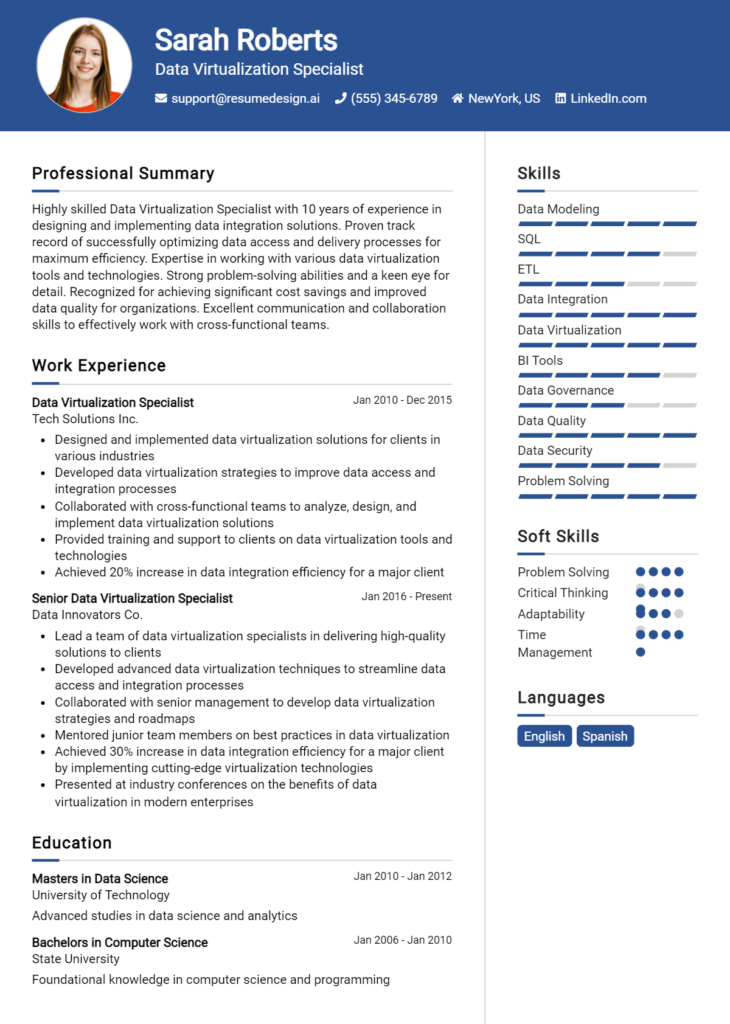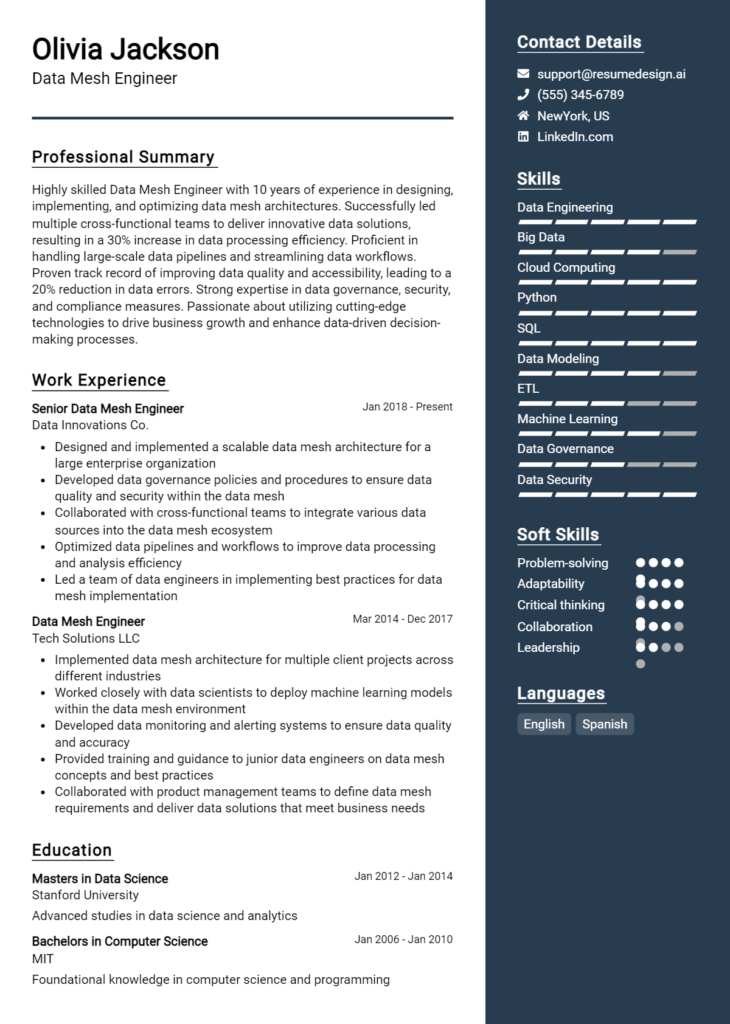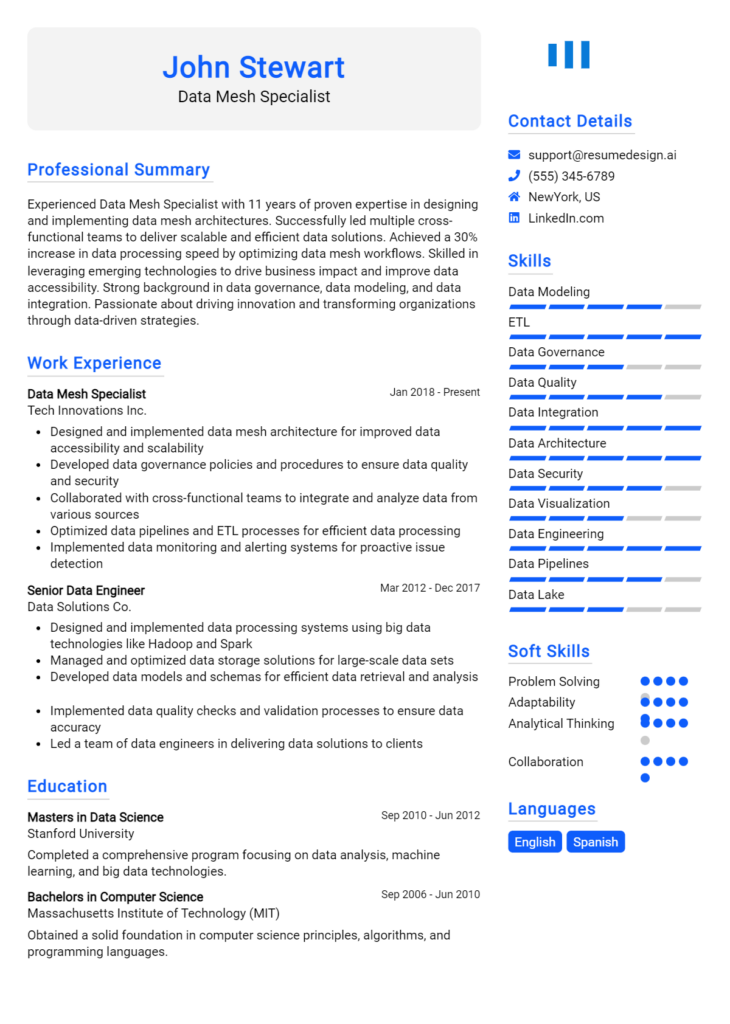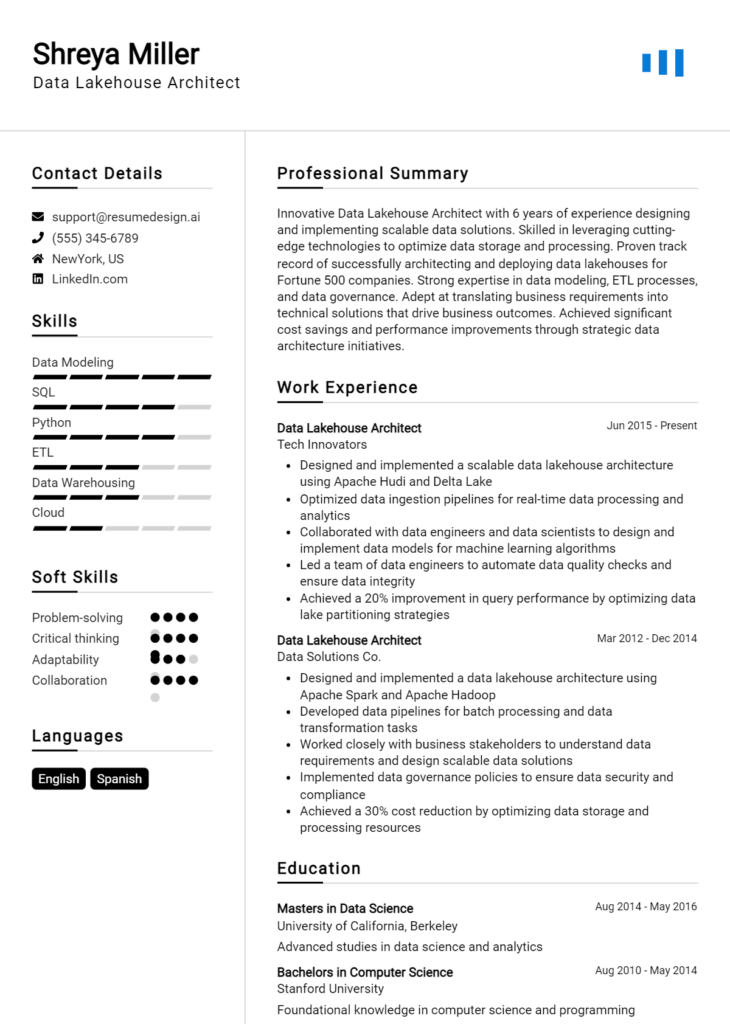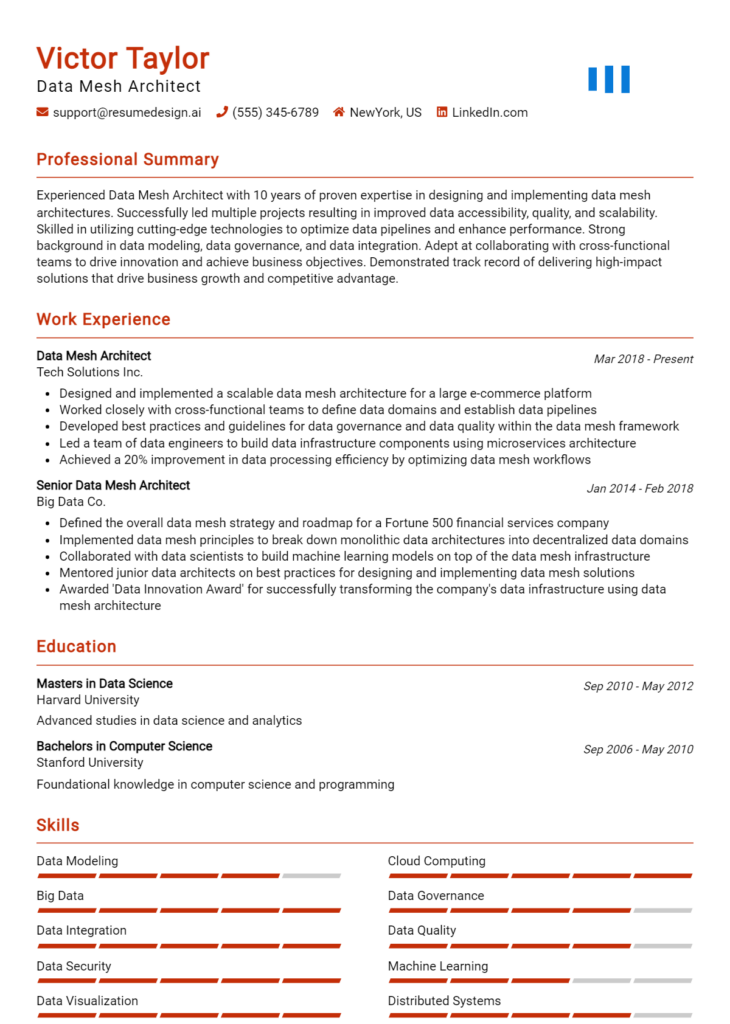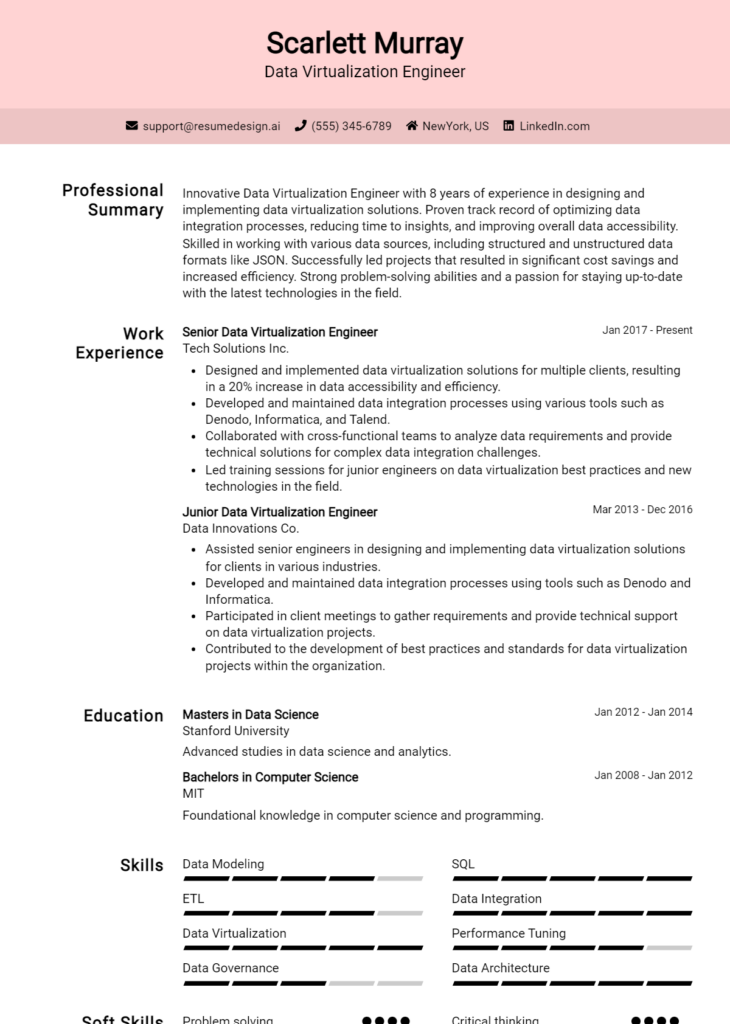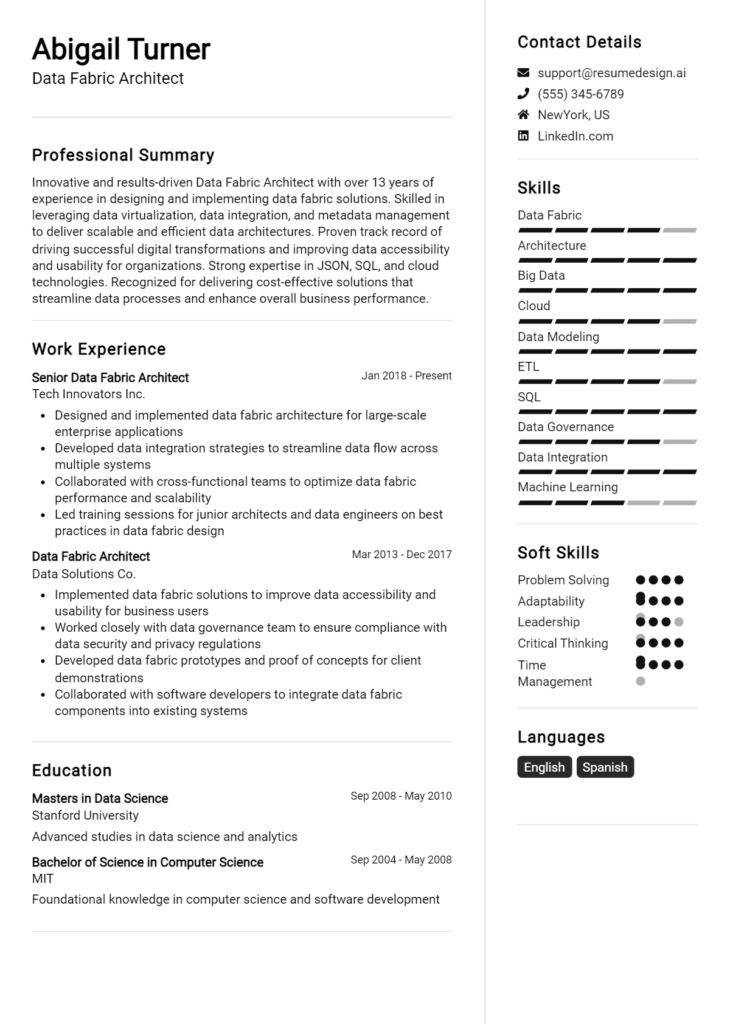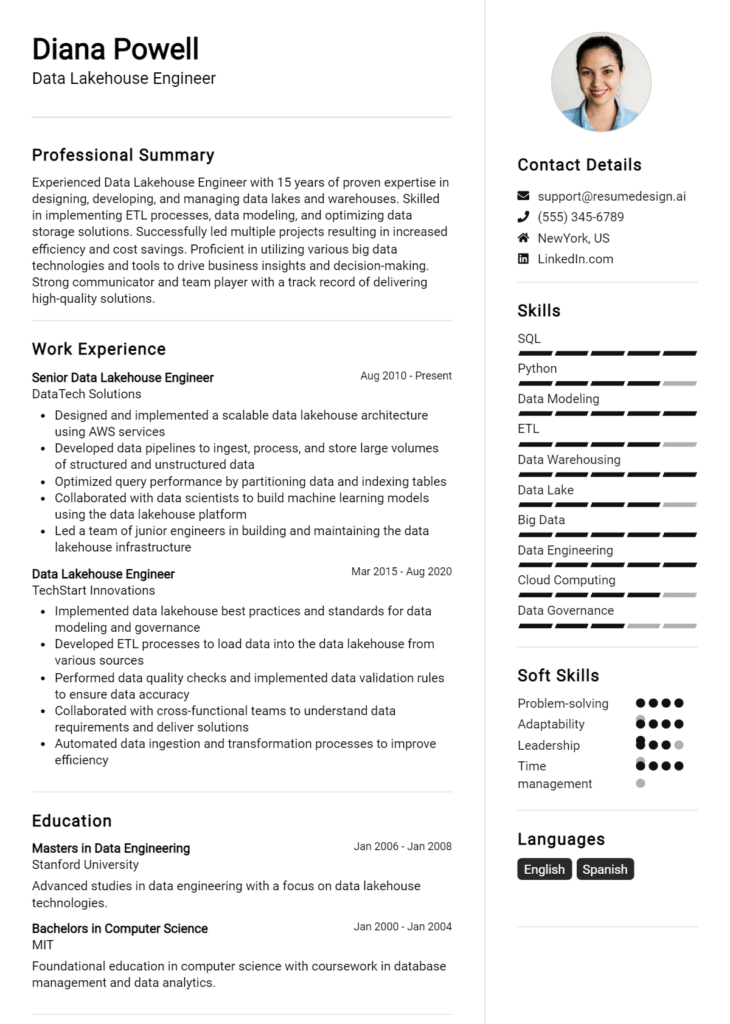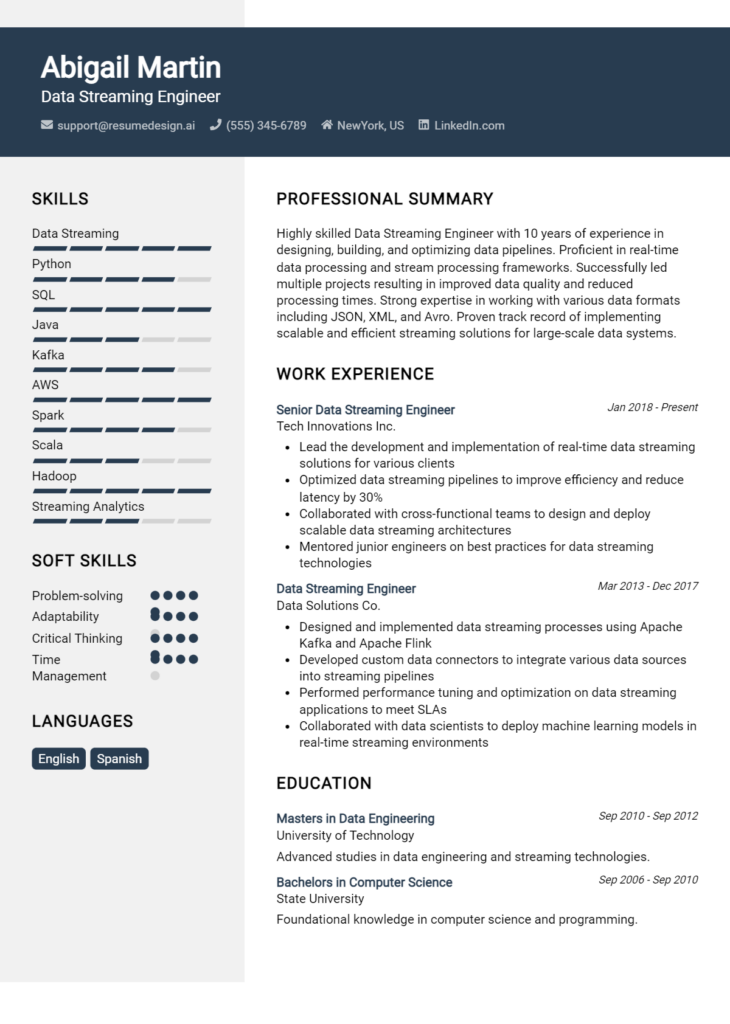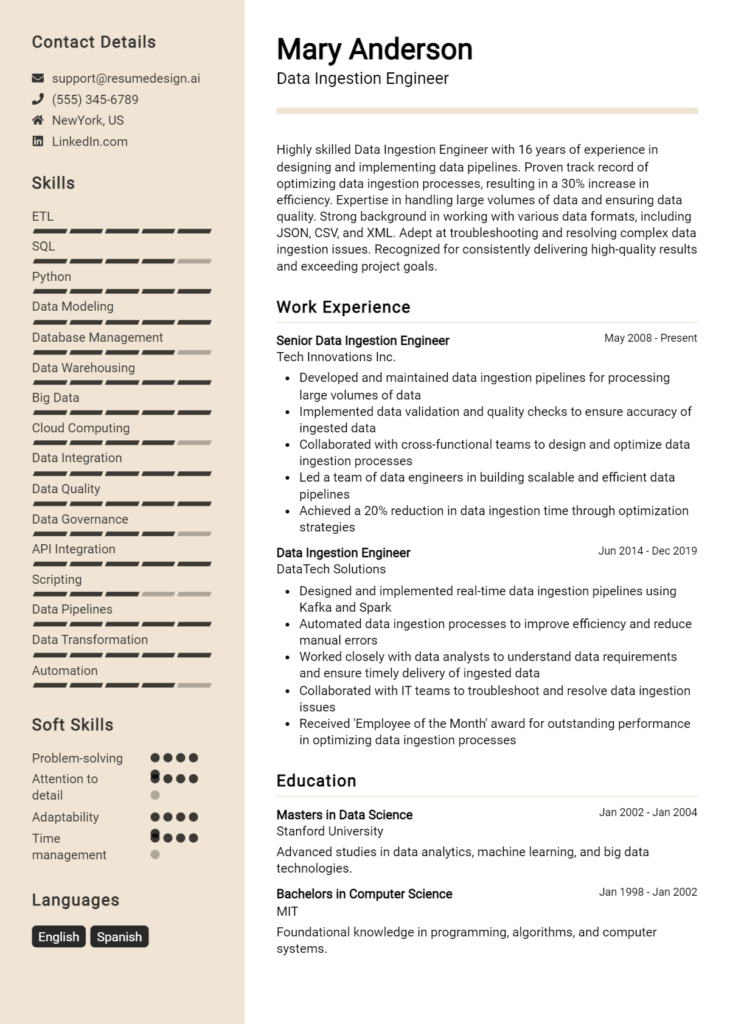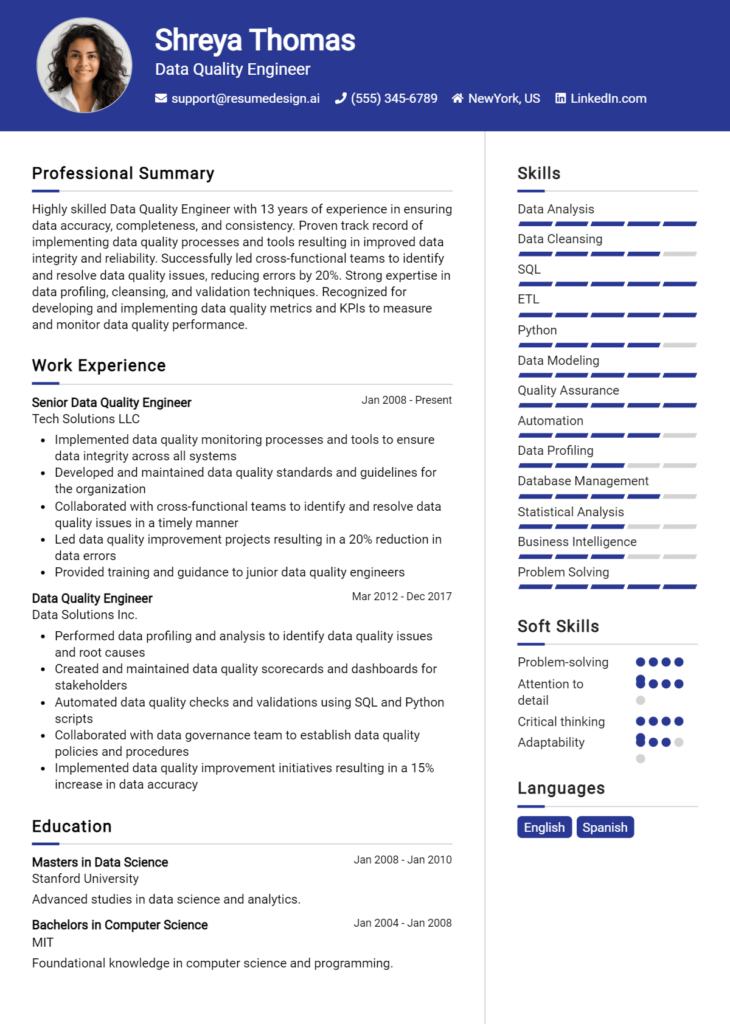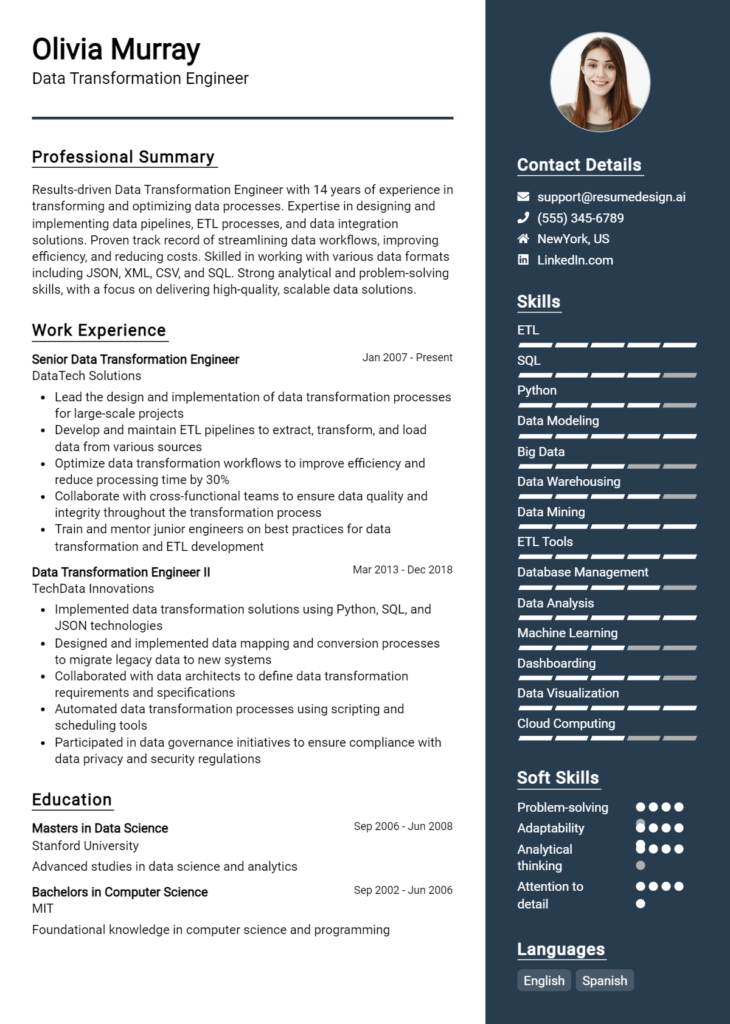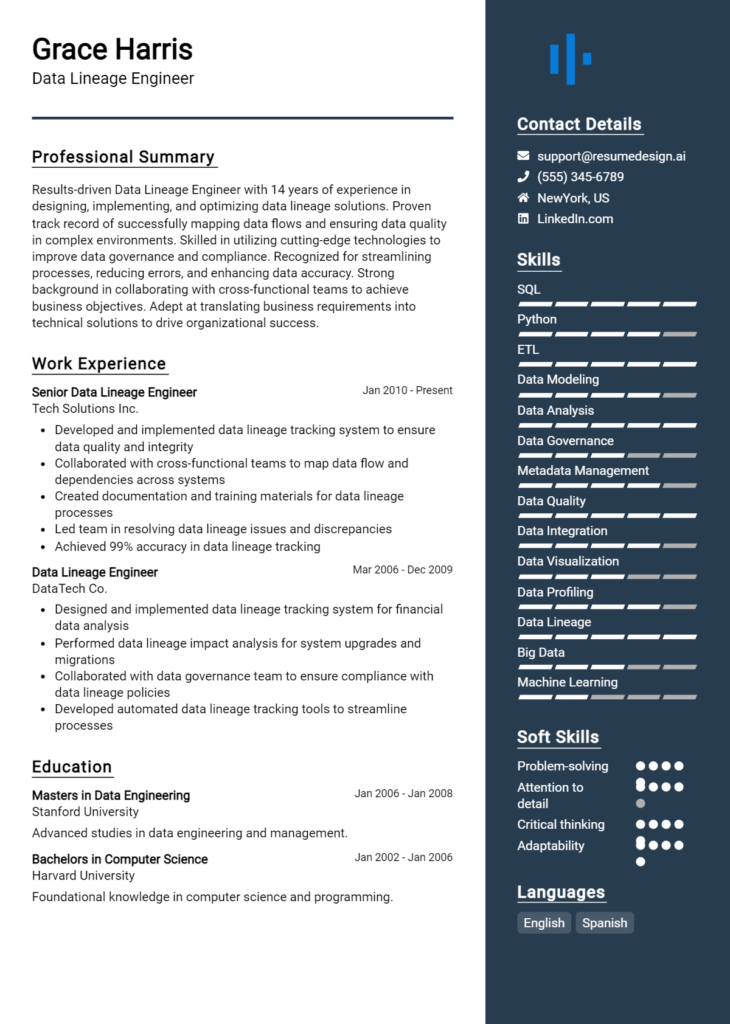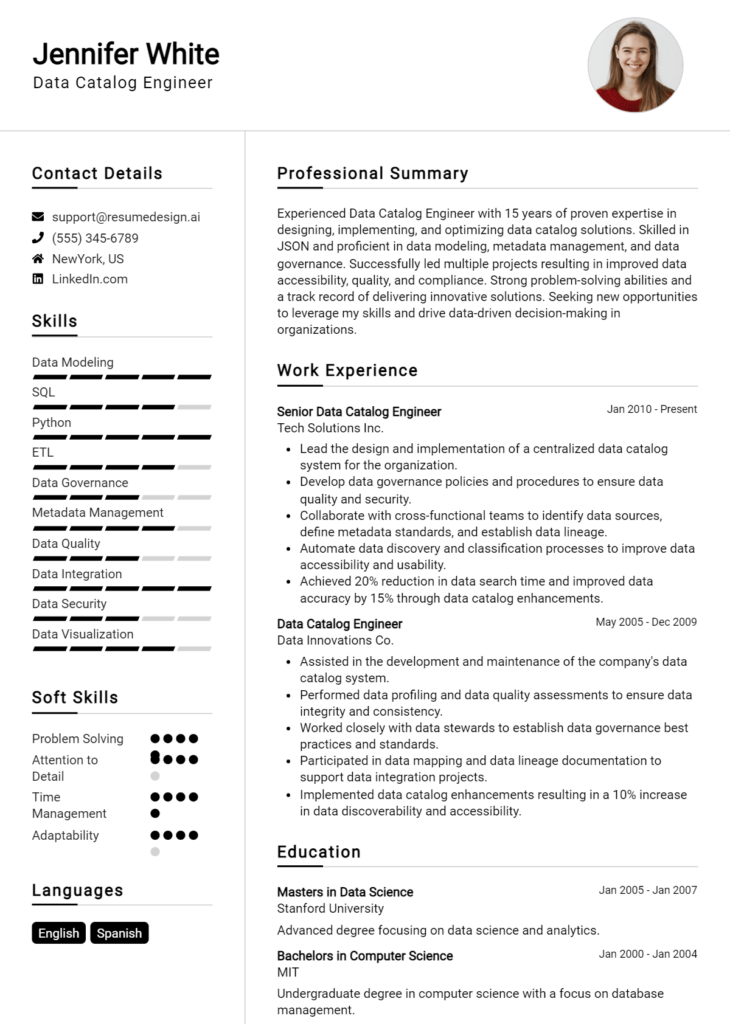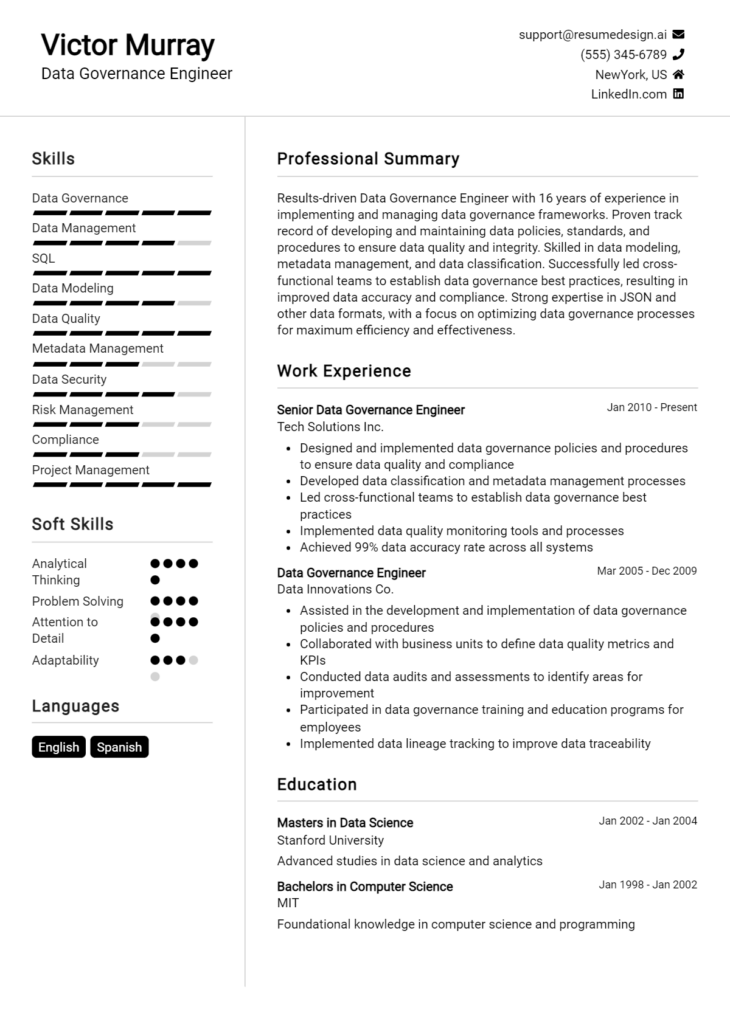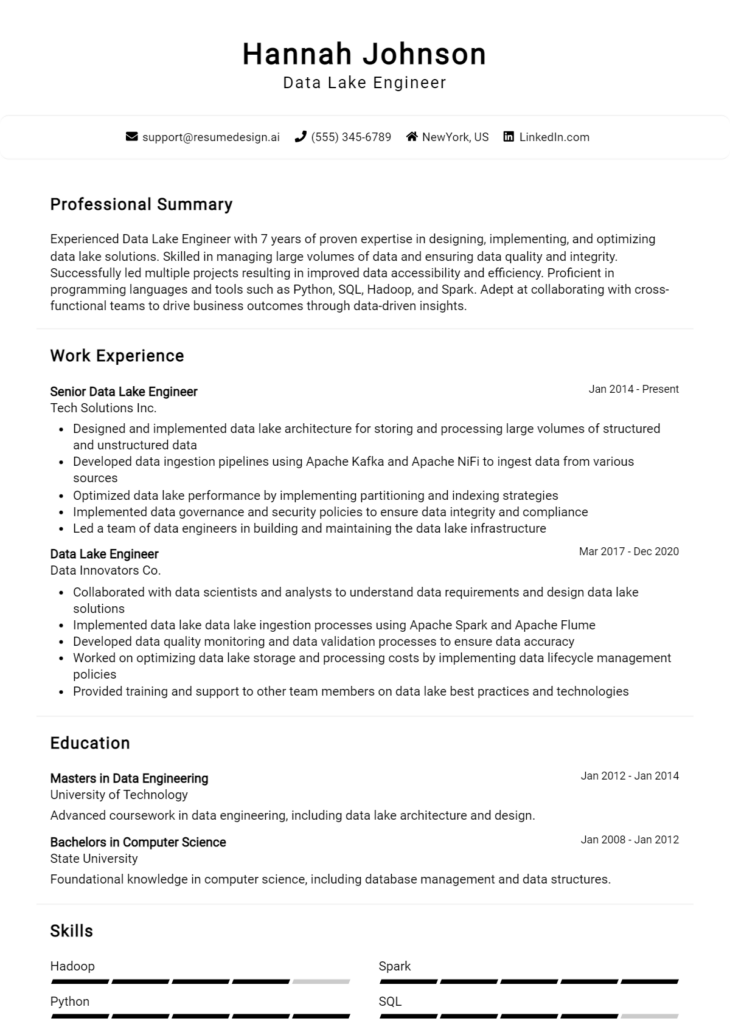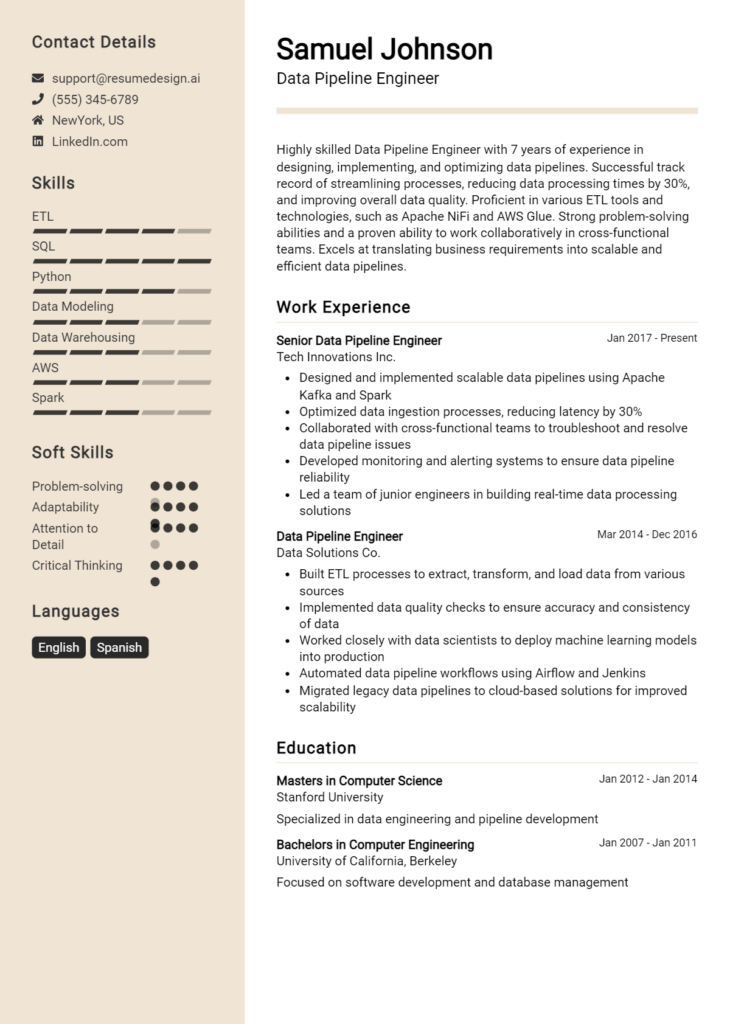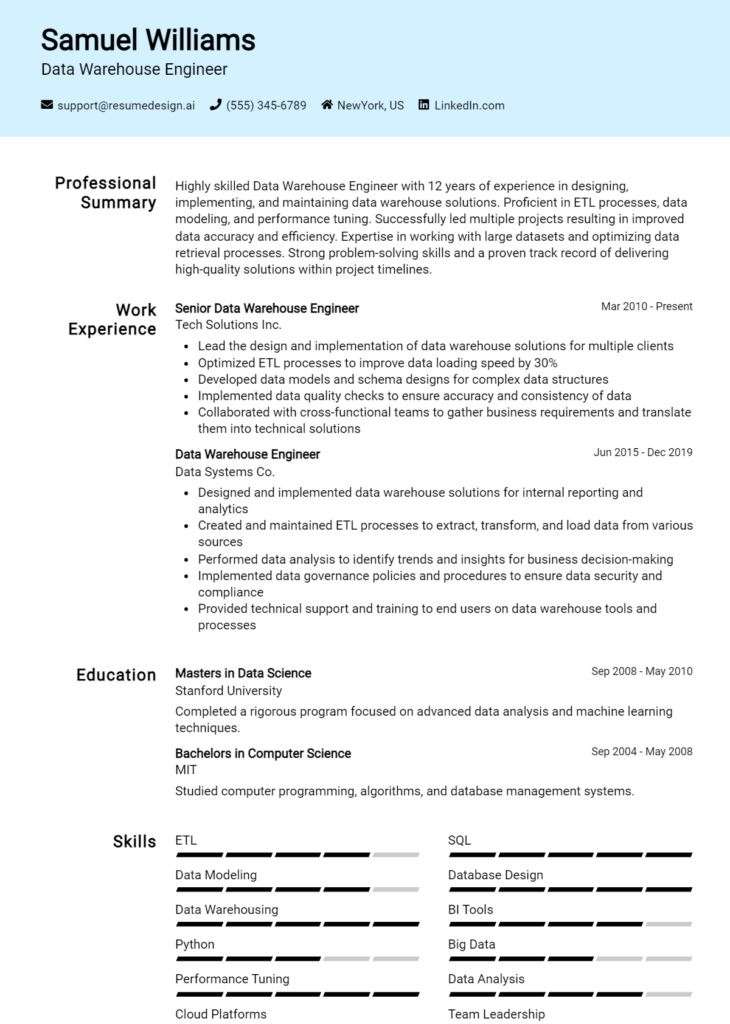Data Fabric Engineer Core Responsibilities
A Data Fabric Engineer plays a crucial role in bridging various departments by ensuring seamless data integration and accessibility across the organization. Key responsibilities include designing and implementing data fabric solutions, collaborating with IT and business teams, and optimizing data workflows. Essential skills encompass advanced technical knowledge, operational efficiency, and strong problem-solving abilities. These competencies are vital for driving analytics and business intelligence initiatives, ultimately contributing to the organization's strategic goals. A well-structured resume can effectively highlight these qualifications and experiences, enhancing job prospects.
Common Responsibilities Listed on Data Fabric Engineer Resume
- Design and implement data fabric architecture and solutions.
- Integrate disparate data sources into a cohesive data environment.
- Collaborate with cross-functional teams to understand data needs.
- Optimize data workflows and processes for efficiency.
- Monitor data quality and establish governance frameworks.
- Develop and maintain documentation for data integration processes.
- Utilize data modeling tools to support analytics initiatives.
- Implement security measures for sensitive data management.
- Conduct performance tuning and troubleshooting of data systems.
- Stay updated with industry trends and emerging technologies.
- Provide training and support to users regarding data access.
High-Level Resume Tips for Data Fabric Engineer Professionals
For professionals in the field of Data Fabric Engineering, crafting a well-structured resume is crucial, as it serves as the first point of contact with potential employers. In a competitive job market, your resume must not only showcase your technical skills and industry knowledge but also highlight your achievements and the impact you've made in previous roles. A compelling resume can set you apart from the competition, making it essential to ensure that it reflects your expertise and aligns with the expectations of hiring managers. This guide will provide practical and actionable resume tips specifically tailored for Data Fabric Engineer professionals, helping you to create a standout application.
Top Resume Tips for Data Fabric Engineer Professionals
- Tailor your resume to the job description by incorporating relevant keywords and phrases.
- Highlight your experience with data integration, data governance, and data management tools.
- Showcase specific projects where you successfully implemented data fabric solutions.
- Quantify your achievements by including metrics that demonstrate your contributions, such as reduced data processing time or improved data quality.
- Emphasize your proficiency with programming languages and frameworks commonly used in data fabric engineering, such as SQL, Python, or Apache Kafka.
- Include certifications and relevant training that enhance your credibility in the field.
- Utilize a clear and organized format that makes it easy for hiring managers to skim through your qualifications.
- Incorporate soft skills that are valuable in collaborative environments, such as communication, problem-solving, and teamwork.
- Keep your resume concise, ideally one to two pages, focusing on the most relevant information.
By implementing these tips, Data Fabric Engineer professionals can significantly enhance their resumes, increasing their chances of catching the attention of recruiters and landing job opportunities in this specialized field. A well-crafted resume not only highlights your qualifications but also demonstrates your understanding of the industry's demands, making you a strong candidate for prospective employers.
Why Resume Headlines & Titles are Important for Data Fabric Engineer
In the competitive landscape of job applications, a Data Fabric Engineer's resume must stand out, and one of the most effective ways to achieve this is through a compelling resume headline or title. A strong headline serves as the first impression for hiring managers, succinctly summarizing a candidate’s key qualifications and career focus in just a few words. This brief yet impactful phrase can immediately grab the attention of recruiters, making it essential for candidates to craft a title that is concise, relevant, and directly related to the job being applied for. A well-thought-out headline not only showcases the candidate's expertise but also aligns with the specific requirements of the Data Fabric Engineer role, enhancing the chances of getting noticed in a crowded applicant pool.
Best Practices for Crafting Resume Headlines for Data Fabric Engineer
- Keep it concise—aim for one impactful phrase.
- Include relevant keywords from the job description.
- Highlight key skills or certifications related to data fabric technology.
- Tailor the headline to match the specific job title being applied for.
- Use action-oriented language to convey a sense of achievement.
- Avoid jargon unless it is industry-specific and well understood.
- Ensure it reflects your unique selling proposition and value to potential employers.
- Consider including years of experience or notable achievements for added credibility.
Example Resume Headlines for Data Fabric Engineer
Strong Resume Headlines
Data Fabric Engineer with 5+ Years of Experience in Cloud Integration and Data Governance
Innovative Data Fabric Specialist Skilled in Real-time Data Processing and Analytics
Results-Driven Data Fabric Engineer | Expertise in ETL Processes and Data Quality Management
Weak Resume Headlines
Engineer Seeking Opportunities
Data Specialist Looking for a Job
The strong headlines are effective because they are specific, highlighting relevant skills, years of experience, and a clear focus on the Data Fabric Engineer role. They communicate the candidate's strengths in a way that resonates with hiring managers, making it easier for them to see the value the candidate could bring to their organization. In contrast, the weak headlines fail to impress due to their vagueness and lack of specificity, leaving hiring managers unsure about the candidate’s qualifications and suitability for the position. By avoiding generic phrases and instead opting for targeted, impactful headlines, candidates can significantly enhance their chances of making a positive first impression.
Writing an Exceptional Data Fabric Engineer Resume Summary
A well-crafted resume summary is crucial for a Data Fabric Engineer as it serves as the first impression to hiring managers. This brief yet impactful section allows candidates to quickly highlight their most relevant skills, experiences, and accomplishments tailored to the specific job role. A strong summary captures attention by succinctly presenting the candidate's value, making it easier for employers to identify them as a fitting candidate for the position. In a competitive job market, where hiring managers sift through numerous resumes, a concise and compelling summary can make all the difference in securing an interview.
Best Practices for Writing a Data Fabric Engineer Resume Summary
- Quantify Achievements: Use numbers and metrics to highlight your successes, making your accomplishments tangible.
- Focus on Key Skills: Emphasize relevant technical skills, such as data integration, management, and analytic tools.
- Tailor the Summary: Customize your summary for each job application to align with the job description and company needs.
- Keep it Concise: Aim for 3-5 sentences that deliver your message clearly without overwhelming the reader.
- Use Action Words: Start with strong action verbs to convey confidence and initiative.
- Highlight Industry Knowledge: Mention any specific frameworks or technologies relevant to data fabrics that showcase your expertise.
- Showcase Problem-Solving Skills: Briefly describe how you've addressed challenges in past roles, demonstrating your critical thinking.
- Include Certifications: If applicable, mention any relevant certifications that add credibility to your qualifications.
Example Data Fabric Engineer Resume Summaries
Strong Resume Summaries
Results-driven Data Fabric Engineer with over 6 years of experience optimizing data integration processes, achieving a 30% increase in data retrieval efficiency. Proficient in leveraging cloud technologies and data orchestration frameworks, including Apache NiFi and AWS Glue, to streamline data flow and enhance analytics capabilities.
Detail-oriented Data Fabric Engineer with a proven track record of implementing data solutions that improved operational efficiency by 25%. Skilled in data governance, ETL processes, and utilizing machine learning algorithms to derive actionable insights from large datasets.
Dynamic Data Fabric Engineer with expertise in building scalable data architectures, resulting in a 40% reduction in data processing time. Adept at collaborating with cross-functional teams to deliver robust data solutions that support business intelligence initiatives.
Weak Resume Summaries
Experienced data engineer looking for a challenging position in the data field. I have skills in various technologies and am eager to work with data.
Data professional with knowledge in data management and analytics. I am interested in contributing to a team that values data-driven decision-making.
The strong resume summaries are effective because they provide specific, quantifiable achievements and demonstrate relevant skills directly related to the Data Fabric Engineer role. They clearly outline the candidate's contributions and the value they can bring to potential employers. In contrast, the weak summaries lack specificity and measurable outcomes, making them less impactful and memorable. They fail to convey the candidate's direct relevance to the job, leaving hiring managers with a vague impression of their qualifications.
Work Experience Section for Data Fabric Engineer Resume
The work experience section of a Data Fabric Engineer resume is a vital component that provides potential employers with insights into a candidate's technical expertise, leadership capabilities, and track record of delivering high-quality data solutions. This section not only highlights specific skills related to data fabric technology but also emphasizes the individual's ability to manage teams effectively and contribute to successful project outcomes. By quantifying achievements and aligning experiences with industry standards, candidates can demonstrate their value and readiness to tackle complex data challenges in modern enterprises.
Best Practices for Data Fabric Engineer Work Experience
- Highlight relevant technologies and tools such as data integration platforms, ETL processes, and cloud services.
- Use quantifiable metrics to demonstrate the impact of your work, such as performance improvements or cost savings.
- Showcase leadership skills by detailing experiences in managing teams or mentoring junior engineers.
- Align your experiences with industry standards and best practices in data management and engineering.
- Include specific projects that illustrate your problem-solving capabilities and technical innovation.
- Emphasize collaboration with cross-functional teams to highlight your ability to work in diverse environments.
- Tailor your experiences to match the job description, using relevant keywords and phrases.
- Keep descriptions concise yet informative, focusing on the most impactful aspects of your role.
Example Work Experiences for Data Fabric Engineer
Strong Experiences
- Led a team of 5 engineers to design and implement a data fabric solution that improved data retrieval times by 40%, enhancing overall operational efficiency.
- Developed and deployed an automated ETL pipeline that reduced data processing time from 24 hours to 2 hours, resulting in a 10% increase in reporting accuracy.
- Collaborated with cross-functional teams to integrate machine learning models into the data fabric architecture, increasing predictive analytics capabilities by 30%.
- Managed a successful migration of legacy systems to a cloud-based data platform, achieving a 25% reduction in infrastructure costs.
Weak Experiences
- Worked on data-related tasks that involved various technologies.
- Assisted in projects that required data analysis.
- Participated in team meetings to discuss data solutions.
- Helped with some aspects of data integration.
The examples presented highlight the differences between strong and weak experiences in a Data Fabric Engineer resume. Strong experiences are characterized by concrete achievements, quantifiable outcomes, and specific technical contributions, showcasing the candidate's ability to deliver impactful results. In contrast, weak experiences tend to be vague, lacking detail and measurable outcomes, which do not effectively convey the candidate's capabilities or contributions to prospective employers.
Education and Certifications Section for Data Fabric Engineer Resume
The education and certifications section of a Data Fabric Engineer resume is crucial in establishing a candidate's qualifications and expertise in the field. This section not only showcases the candidate's academic achievements but also highlights industry-relevant certifications and their commitment to continuous learning. By providing details on relevant coursework, recognized certifications, and specialized training, candidates can significantly enhance their credibility and demonstrate their alignment with the specific requirements of the Data Fabric Engineer role. A well-structured education and certifications section can set a candidate apart in a competitive job market.
Best Practices for Data Fabric Engineer Education and Certifications
- Focus on relevant degrees, such as Computer Science, Data Science, or Information Systems.
- Include industry-recognized certifications, such as AWS Certified Data Analytics or Google Cloud Professional Data Engineer.
- Highlight specialized training in data management, integration, or fabric technologies.
- Detail relevant coursework that pertains to data engineering or analytics.
- Keep the section concise and focused on the most impactful qualifications.
- Update regularly to reflect new certifications or educational achievements.
- Use clear formatting to make it easy for hiring managers to identify key credentials.
- Avoid including unrelated degrees or certifications that do not pertain to the role.
Example Education and Certifications for Data Fabric Engineer
Strong Examples
- Bachelor of Science in Computer Science, University of Data Science, 2020
- AWS Certified Data Analytics - Specialty, Amazon Web Services, 2022
- Google Cloud Professional Data Engineer Certification, 2021
- Coursework in Data Architecture and Integration Techniques, University of Data Science
Weak Examples
- Bachelor of Arts in English Literature, University of Literature, 2015
- Certification in Basic Microsoft Office, 2018
- Coursework in History of Computing, 2019
- High School Diploma, 2012
The strong examples are considered relevant as they align directly with the skills and knowledge required for a Data Fabric Engineer, showcasing both academic and professional development in data-related fields. In contrast, the weak examples lack relevance to the role, featuring degrees and certifications that do not contribute to the required expertise in data engineering, thus failing to enhance the candidate's qualifications for the position.
Top Skills & Keywords for Data Fabric Engineer Resume
As the demand for data-driven decision-making grows across industries, the role of a Data Fabric Engineer has become increasingly vital. A well-crafted resume that highlights the right skills can make a significant difference in securing a position in this competitive field. Skills not only demonstrate a candidate’s technical proficiency but also reflect their ability to collaborate, problem-solve, and adapt in a dynamic environment. A Data Fabric Engineer must possess a blend of both hard and soft skills to effectively manage, integrate, and analyze data from various sources, ensuring that organizations can leverage their data for strategic advantages.
Top Hard & Soft Skills for Data Fabric Engineer
Soft Skills
- Effective Communication
- Problem-Solving
- Critical Thinking
- Team Collaboration
- Adaptability
- Attention to Detail
- Time Management
- Creativity
- Analytical Mindset
- Conflict Resolution
Hard Skills
- Data Integration Techniques
- Knowledge of Data Lakes and Warehousing
- Proficiency in ETL Tools (e.g., Talend, Apache NiFi)
- Familiarity with SQL and NoSQL Databases
- Experience with Cloud Platforms (e.g., AWS, Azure, GCP)
- Understanding of Data Governance and Compliance
- Data Modeling and Architecture Design
- Proficiency in Programming Languages (e.g., Python, Java)
- Familiarity with Big Data Technologies (e.g., Hadoop, Spark)
- Knowledge of Machine Learning Concepts
To further enhance your resume, consider integrating specific skills and showcasing relevant work experience that align with the expectations of a Data Fabric Engineer. This approach can effectively position you as a strong candidate in the data engineering landscape.
Stand Out with a Winning Data Fabric Engineer Cover Letter
As a passionate and experienced Data Fabric Engineer, I am excited to apply for the position at [Company Name]. With a solid background in data architecture and integration, I have developed a keen understanding of how to create seamless data ecosystems that enhance business intelligence and decision-making. My expertise in implementing data fabric solutions has enabled organizations to break down silos and access real-time data insights, ultimately driving operational efficiency and fostering innovation.
In my previous role at [Previous Company Name], I successfully led the design and implementation of a robust data fabric architecture that integrated disparate data sources across the organization. By leveraging cutting-edge technologies such as Apache Kafka, Hadoop, and cloud-based solutions, I was able to facilitate a more agile data environment that significantly improved data accessibility for analytics teams. My collaborative approach allowed me to work closely with cross-functional teams, ensuring that data governance and security measures were meticulously followed while aligning data strategies with business objectives.
I am particularly impressed with [Company Name]'s commitment to leveraging advanced data solutions to drive business growth. I am eager to bring my skills in data modeling, ETL processes, and machine learning integration to your team. I am also a strong advocate for continuous learning and innovation, always seeking out the latest trends and best practices in the data engineering field. I believe that my proactive mindset and dedication to optimizing data workflows will make a valuable addition to your organization.
Thank you for considering my application. I am looking forward to the opportunity to discuss how my experience and vision align with the goals of [Company Name]. I am excited about the prospect of contributing to your data initiatives and helping shape a data-driven culture that enhances decision-making and drives success.
Common Mistakes to Avoid in a Data Fabric Engineer Resume
Crafting a resume for a Data Fabric Engineer position requires careful attention to detail, as this role demands a specific set of skills and experience. However, many candidates make common mistakes that can hinder their chances of landing an interview. By avoiding these pitfalls, you can ensure your resume effectively showcases your qualifications and expertise in the field. Here are some mistakes to watch out for:
Lack of Relevant Keywords: Failing to include industry-specific keywords can cause your resume to be overlooked by Applicant Tracking Systems (ATS) that screen for specific terms related to data fabric technologies.
Generic Objectives or Summaries: Using a one-size-fits-all objective statement does not effectively communicate your unique qualifications. Tailor your summary to reflect your specific skills and experiences relevant to the Data Fabric Engineer role.
Ignoring Quantifiable Achievements: Simply listing job duties without quantifiable results can make your contributions seem less impactful. Use metrics to demonstrate how you improved data integration processes or optimized data workflows.
Overloading with Technical Jargon: While technical proficiency is crucial, overwhelming your resume with jargon can alienate non-technical HR personnel. Strike a balance by explaining concepts in a clear, concise manner.
Neglecting Soft Skills: Data Fabric Engineers often work in teams and need to communicate effectively. Failing to highlight essential soft skills such as collaboration, problem-solving, and communication can make your resume less appealing.
Inconsistent Formatting: A cluttered or inconsistent resume format can distract from the content. Ensure uniformity in font sizes, bullet points, and spacing to present a professional appearance.
Omitting Continuing Education: The field of data engineering is constantly evolving. Not mentioning relevant certifications, workshops, or courses can make it appear that you are not keeping your skills up-to-date.
Not Customizing for Each Application: Sending out the same resume for every job application can be detrimental. Tailoring your resume to match the specific requirements and preferences of each prospective employer can significantly improve your chances of getting noticed.
Conclusion
As a Data Fabric Engineer, you play a crucial role in integrating and managing data across diverse environments, ensuring seamless accessibility and usability for both data scientists and business analysts. Throughout this article, we’ve explored the key responsibilities of this role, including data integration, data governance, and the implementation of data management strategies that leverage advanced technologies.
We also highlighted the importance of having a strong skill set that encompasses data architecture, cloud platforms, and knowledge of data processing frameworks. It's essential to stay updated with the latest trends and tools in data management to excel in your career.
Now that you have a clearer understanding of the Data Fabric Engineer role and its demands, it's time to reflect on your qualifications and experiences. Are they effectively showcased in your resume? A well-crafted resume can significantly enhance your job prospects.
We encourage you to take a moment to review your Data Fabric Engineer resume. To assist you in this process, consider utilizing the following resources:
- Explore resume templates to find a design that suits your style.
- Use the resume builder to create a polished document quickly and easily.
- Check out resume examples for inspiration on how to highlight your skills and experiences effectively.
- Don’t forget to craft a compelling cover letter with our cover letter templates to accompany your resume.
Take action today and ensure your resume stands out in the competitive job market!

